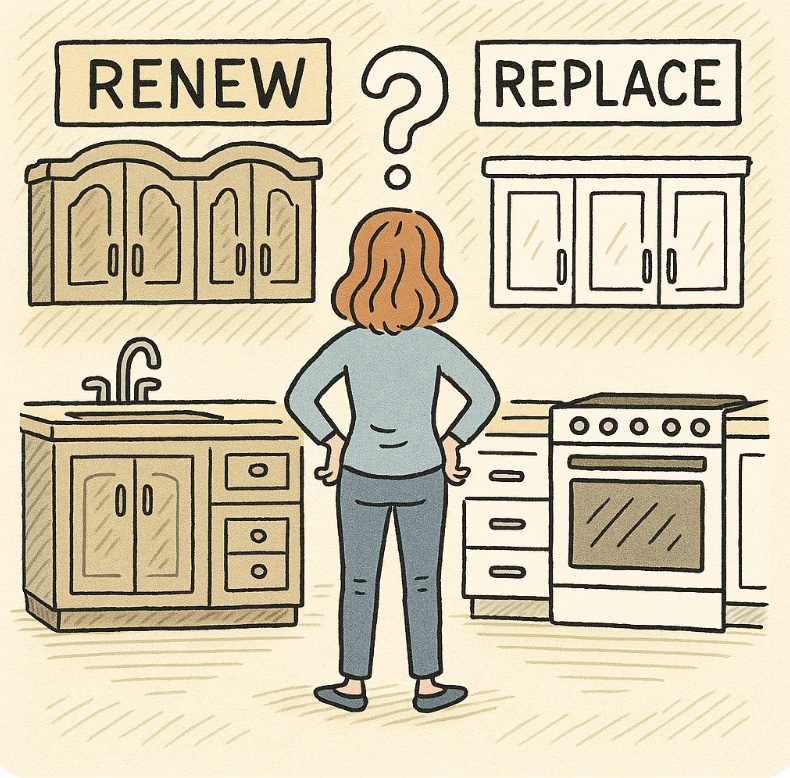
If your kitchen still looks like it belongs in a 2005 magazine spread — dark cherry cabinets, busy granite, and a clunky peninsula — you’re not alone. Many homes built or remodeled in the early 2000s are starting to feel dated.
The big question: what’s the best way to modernize?
Some homeowners think about painting or refinishing, but that’s usually a short-term band-aid. If you want a kitchen that truly feels fresh, functional, and built to last, replacing your cabinets is the smarter move. Here’s why.
Why We Don’t Recommend Painting or Refinishing
Painting or refinishing cabinets is often the first idea homeowners consider — it feels quick and affordable. And yes, it can freshen things up for a short while.
But here’s the reality: painted cabinets chip, peel, and show wear quickly. Refinishing doesn’t fix outdated door styles, awkward layouts, or poor storage design. Most homeowners who go this route end up wishing they had invested in new cabinetry from the start.
Replacement Advantage: New cabinets not only look better, they give you modern door styles, durable finishes, and improved function — the kind of changes that actually transform a kitchen.
Outdated Granite and Bulky Layouts
Granite with heavy speckles and dark tones was the signature look of mid-2000s kitchens. Pair that with a closed-off peninsula, and your space can feel heavy and dated.
Replacement Advantage: With new cabinetry, you can reconfigure the layout, open up the flow, and select lighter, cleaner finishes that instantly bring your kitchen into today’s design trends.
Modern Kitchens Are Smarter Kitchens
Cabinetry from 15–20 years ago usually lacks the built-in features homeowners now expect. Soft-close hinges, deep drawers, pull-out organizers, and clever storage solutions weren’t standard back then.
Replacement Advantage: A fresh set of cabinets means more than just a pretty face. It’s a chance to design smarter storage and functional zones — like a dedicated coffee station, pantry pull-outs, or a hidden charging drawer.
Cost vs. Value: Why Replacement Pays Off
On the surface, painting or refacing may seem less expensive. But because those fixes don’t address aging cabinet boxes, outdated layouts, or wear-and-tear, they rarely add lasting value. Buyers can tell the difference between a quick facelift and a true upgrade.
Cost vs. Value: A Side-by-Side Look

Breaking it down by cost per year makes it clear: replacement is the most economical option over the long run. But numbers only tell part of the story.
With painting or refacing, you’re still stuck with the same old layout, the same awkward storage, and the same design limitations — just dressed up a little differently.
Replacement is the only option that stacks the best value with the biggest benefit: the freedom to design the kitchen you truly want. That means choosing the door style, finish, layout, and smart storage features that actually fit your life.
Design Freedom, Without the Gut Job
Here’s the best part: replacing cabinets doesn’t always mean tearing your kitchen down to the studs. With the right design team, you can keep the existing footprint where it makes sense while updating the elements that matter most.
Think: new cabinetry, countertops, backsplash, and lighting — all without moving plumbing or knocking out walls (unless you want to).
The Bottom Line
If your kitchen is stuck in 2005, don’t settle for a short-term fix like paint that chips and fades. The smartest way to modernize is to start fresh with cabinetry designed for today’s style, function, and quality.
At Belle Design Collective, we help San Diego homeowners transform dated kitchens into timeless, functional spaces. Our showroom makes it easy to see cabinet lines, compare finishes, and explore design options that fit your home and budget.
Ready to bring your kitchen into the present? Schedule a consultation and let’s get started.
Written by Emily Wold
Owner of Belle Design Collective, San Diego & Seattle
Ready to modernize your kitchen?
Request a Free Quote
Request a Free Quote Today
Submit Request
What service are you interested in? (list all that apply) Cabinets, architectural design, and/or interior design?
⭐ Proudly rated 5.0 on Google — see what our clients say.